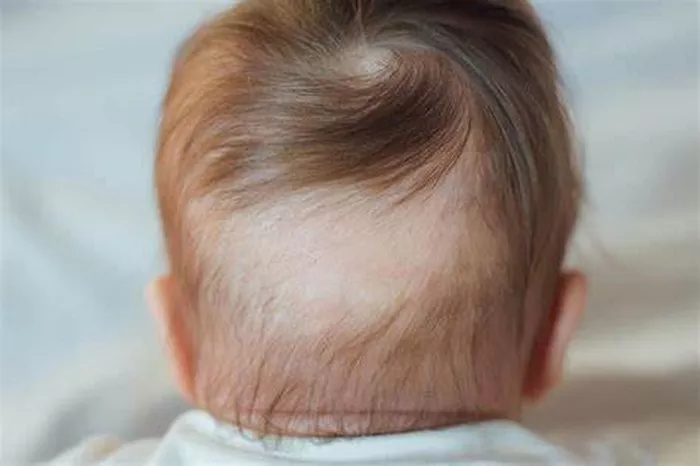Newborn hair loss, a common yet sometimes alarming phenomenon for new parents, raises many questions and concerns. Observing your baby’s hair thinning or falling out can be worrisome, but it is generally a normal part of infancy. This article aims to delve into the intricacies of newborn hair loss, exploring its causes, patterns, and ways to care for your baby’s scalp and hair during this period.
Understanding Newborn Hair Growth
The Two Types of Hair
Newborns are born with two types of hair: vellus and terminal.
Vellus Hair: This is the soft, fine hair that covers most of the body and is typically less pigmented.
Terminal Hair: This is the coarser, darker hair that usually covers the scalp, eyebrows, and eyelashes.
The Hair Growth Cycle
Hair growth follows a cycle consisting of three phases:
Anagen (Growth Phase): This is when hair is actively growing.
Catagen (Transitional Phase): This short phase marks the end of active growth.
Telogen (Resting Phase): Hair is in a resting state and eventually falls out to make way for new growth.
Newborns often experience a shift in this cycle, leading to hair loss, which is entirely normal.
Causes of Newborn Hair Loss
Hormonal Changes
Hormonal fluctuations are a primary cause of hair loss in newborns. During pregnancy, the mother’s hormones influence the baby’s hair growth. After birth, these hormones decrease, causing hair to enter the telogen phase and fall out.
Friction
Newborns spend much time lying on their backs, leading to friction between their heads and surfaces like mattresses or car seats. This constant rubbing can cause hair to thin out or fall out in certain areas, typically the back of the head.
Normal Hair Shedding
Just as adults shed hair, newborns go through a natural shedding process. This can occur anywhere from birth to six months of age and is usually nothing to worry about.
Cradle Cap
Cradle cap, or seborrheic dermatitis, is a common scalp condition in infants that can cause hair loss. It appears as yellowish, greasy, scaly patches on the scalp and is usually harmless, resolving on its own over time.
Nutritional Factors
While less common, nutritional deficiencies can contribute to hair loss in newborns. Ensuring your baby receives proper nutrition through breastfeeding or formula feeding is crucial for their overall health, including hair growth.
Patterns of Newborn Hair Loss
Diffuse Hair Loss
Some newborns experience diffuse hair loss, where hair falls out evenly across the scalp. This type is typically due to hormonal changes and resolves as new hair grows in.
Patterned Hair Loss
Patterned hair loss, often seen as a bald spot on the back of the head, results from friction. Once babies start spending more time sitting up and moving around, this type of hair loss usually diminishes.
Uneven Hair Loss
Uneven hair loss can occur if one side of the baby’s head experiences more friction than the other. This type is also temporary and will correct itself as the baby grows.
When to Worry About Newborn Hair Loss
Underlying Medical Conditions
In rare cases, hair loss in newborns may indicate an underlying medical condition such as alopecia areata, hypothyroidism, or a fungal infection like ringworm. If hair loss is accompanied by other symptoms, such as redness, swelling, or flaky patches, consult a pediatrician.
Excessive Hair Loss
While some hair loss is normal, excessive hair loss or hair loss that continues beyond six months may warrant a visit to the doctor. Persistent hair loss could be a sign of nutritional deficiencies or other health issues.
Caring for Your Newborn’s Hair and Scalp
Gentle Washing
Wash your baby’s hair with a mild, baby-friendly shampoo. Avoid over-washing, as it can strip the scalp of natural oils. Two to three times a week is usually sufficient.
Soft Brushing
Use a soft-bristled brush to gently brush your baby’s hair. This helps remove any loose hair and stimulates the scalp.
Avoiding Tight Hairstyles
If your baby has longer hair, avoid tying it in tight hairstyles, which can cause tension and lead to hair loss. Opt for loose styles that do not pull on the scalp.
See Also: How to Stop Hair Fall After Dengue: 6 Effective Strategies
Managing Cradle Cap
To manage cradle cap, gently massage your baby’s scalp with a soft brush or cloth before shampooing. This helps loosen the scales. Applying a small amount of baby oil can also help soften the scales.
Ensuring Proper Nutrition
Ensure your baby gets the right nutrition through breastfeeding or formula feeding. Proper nutrition supports overall health and hair growth.
The Emotional Aspect of Newborn Hair Loss
Parental Concerns
Seeing your baby’s hair fall out can be distressing, especially for first-time parents. It is essential to understand that this is a normal process and usually resolves itself without intervention.
Building Confidence
Focusing on your baby’s overall health and development can help ease concerns about hair loss. Celebrate milestones and enjoy bonding with your baby rather than worrying excessively about their hair.
Conclusion
Newborn hair loss is a common and usually normal phenomenon resulting from hormonal changes, friction, and natural shedding processes. Understanding the causes and patterns of hair loss can help parents manage their concerns and care for their baby’s hair and scalp effectively. While most hair loss in newborns is temporary and resolves on its own, it is essential to monitor for any signs of underlying medical conditions and consult a pediatrician if necessary. Embracing this phase as a natural part of your baby’s development can help alleviate worries and allow you to focus on enjoying your time with your little one.


